Financial Analysis of Company Performance
VerifiedAdded on 2020/05/04
|14
|2391
|43
AI Summary
This assignment involves a comprehensive analysis of a company's financial performance over a three-year period (2014-2016) using various financial ratios. Students are tasked with calculating and interpreting profitability ratios, liquidity ratios, and solvency ratios to evaluate the company's financial health. The analysis should shed light on trends in the company's performance, its ability to meet short-term obligations, and its long-term viability. The assignment also includes hypothetical scenarios where students must apply their understanding of financial ratios to make lending decisions.
Contribute Materials
Your contribution can guide someone’s learning journey. Share your
documents today.
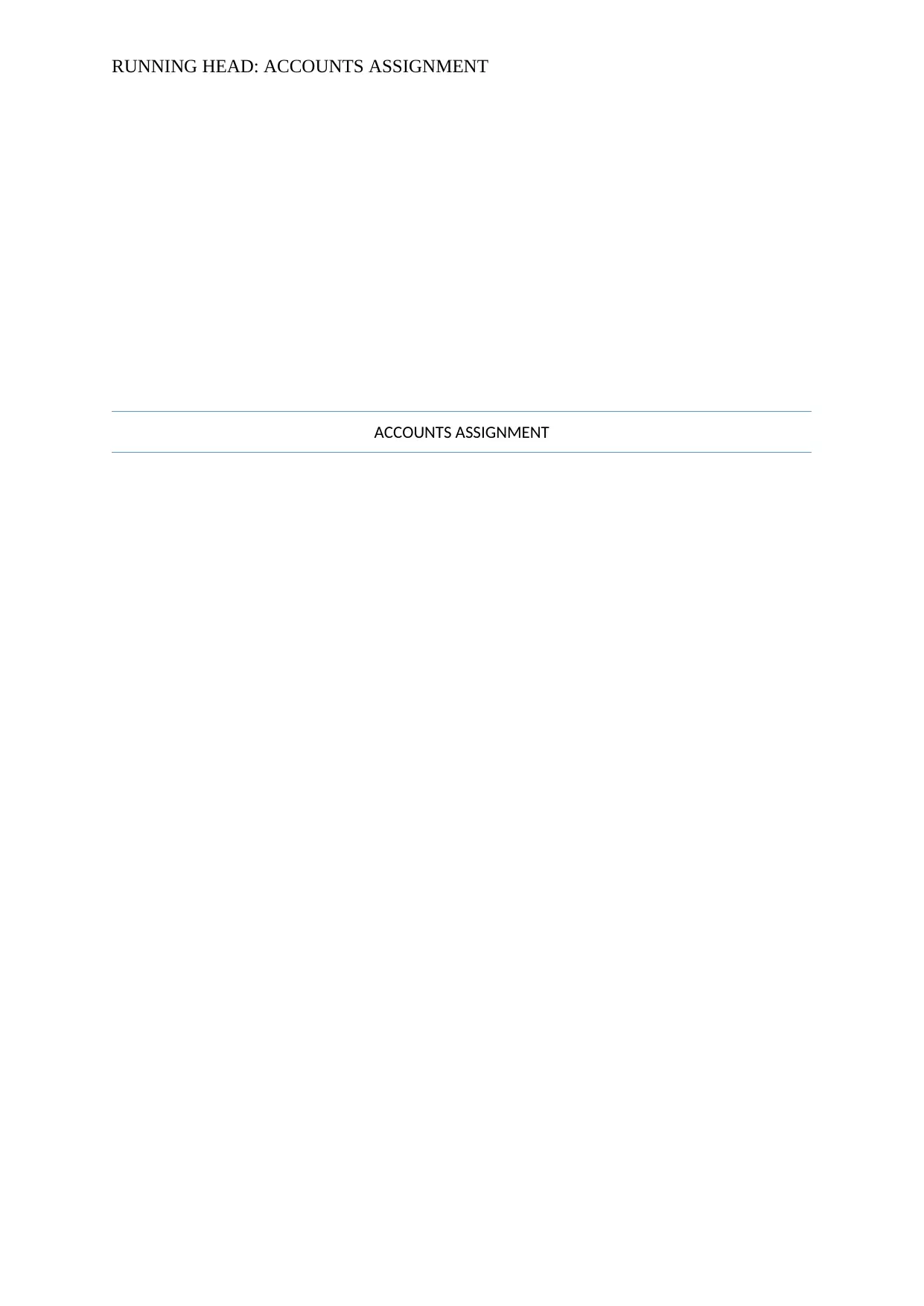
RUNNING HEAD: ACCOUNTS ASSIGNMENT
ACCOUNTS ASSIGNMENT
ACCOUNTS ASSIGNMENT
Secure Best Marks with AI Grader
Need help grading? Try our AI Grader for instant feedback on your assignments.
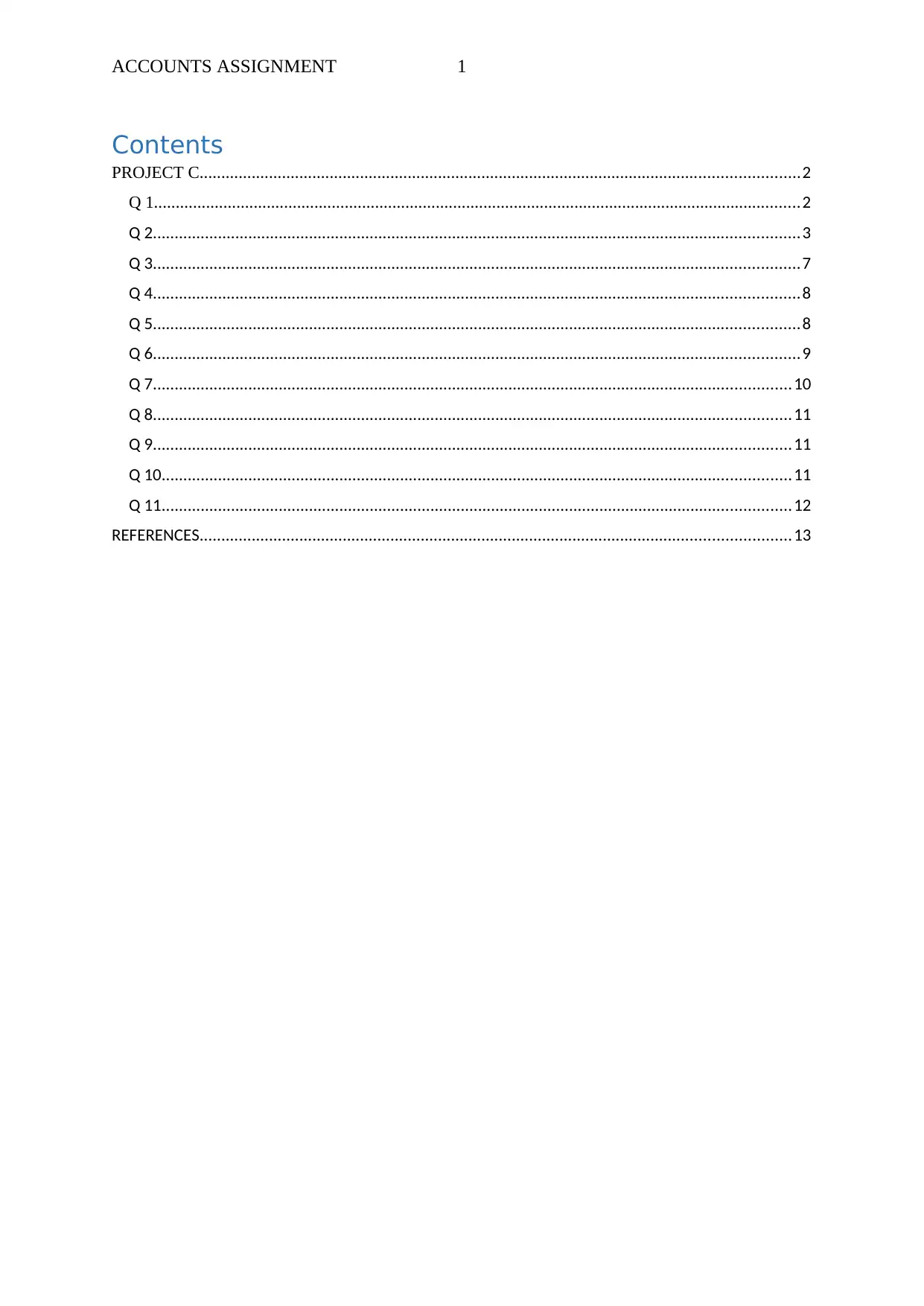
ACCOUNTS ASSIGNMENT 1
Contents
PROJECT C..........................................................................................................................................2
Q 1.....................................................................................................................................................2
Q 2.....................................................................................................................................................3
Q 3.....................................................................................................................................................7
Q 4.....................................................................................................................................................8
Q 5.....................................................................................................................................................8
Q 6.....................................................................................................................................................9
Q 7...................................................................................................................................................10
Q 8...................................................................................................................................................11
Q 9...................................................................................................................................................11
Q 10.................................................................................................................................................11
Q 11.................................................................................................................................................12
REFERENCES........................................................................................................................................13
Contents
PROJECT C..........................................................................................................................................2
Q 1.....................................................................................................................................................2
Q 2.....................................................................................................................................................3
Q 3.....................................................................................................................................................7
Q 4.....................................................................................................................................................8
Q 5.....................................................................................................................................................8
Q 6.....................................................................................................................................................9
Q 7...................................................................................................................................................10
Q 8...................................................................................................................................................11
Q 9...................................................................................................................................................11
Q 10.................................................................................................................................................11
Q 11.................................................................................................................................................12
REFERENCES........................................................................................................................................13
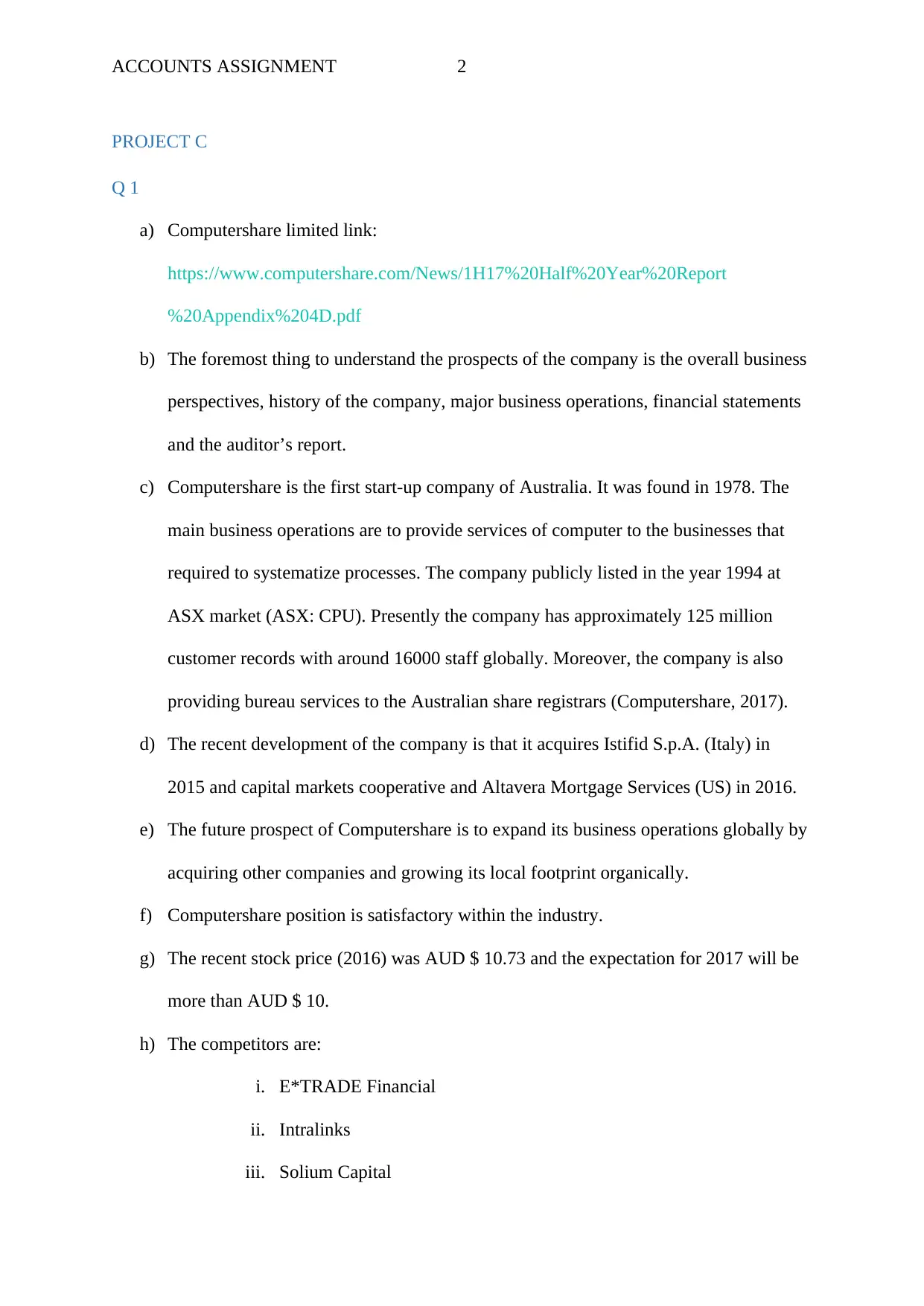
ACCOUNTS ASSIGNMENT 2
PROJECT C
Q 1
a) Computershare limited link:
https://www.computershare.com/News/1H17%20Half%20Year%20Report
%20Appendix%204D.pdf
b) The foremost thing to understand the prospects of the company is the overall business
perspectives, history of the company, major business operations, financial statements
and the auditor’s report.
c) Computershare is the first start-up company of Australia. It was found in 1978. The
main business operations are to provide services of computer to the businesses that
required to systematize processes. The company publicly listed in the year 1994 at
ASX market (ASX: CPU). Presently the company has approximately 125 million
customer records with around 16000 staff globally. Moreover, the company is also
providing bureau services to the Australian share registrars (Computershare, 2017).
d) The recent development of the company is that it acquires Istifid S.p.A. (Italy) in
2015 and capital markets cooperative and Altavera Mortgage Services (US) in 2016.
e) The future prospect of Computershare is to expand its business operations globally by
acquiring other companies and growing its local footprint organically.
f) Computershare position is satisfactory within the industry.
g) The recent stock price (2016) was AUD $ 10.73 and the expectation for 2017 will be
more than AUD $ 10.
h) The competitors are:
i. E*TRADE Financial
ii. Intralinks
iii. Solium Capital
PROJECT C
Q 1
a) Computershare limited link:
https://www.computershare.com/News/1H17%20Half%20Year%20Report
%20Appendix%204D.pdf
b) The foremost thing to understand the prospects of the company is the overall business
perspectives, history of the company, major business operations, financial statements
and the auditor’s report.
c) Computershare is the first start-up company of Australia. It was found in 1978. The
main business operations are to provide services of computer to the businesses that
required to systematize processes. The company publicly listed in the year 1994 at
ASX market (ASX: CPU). Presently the company has approximately 125 million
customer records with around 16000 staff globally. Moreover, the company is also
providing bureau services to the Australian share registrars (Computershare, 2017).
d) The recent development of the company is that it acquires Istifid S.p.A. (Italy) in
2015 and capital markets cooperative and Altavera Mortgage Services (US) in 2016.
e) The future prospect of Computershare is to expand its business operations globally by
acquiring other companies and growing its local footprint organically.
f) Computershare position is satisfactory within the industry.
g) The recent stock price (2016) was AUD $ 10.73 and the expectation for 2017 will be
more than AUD $ 10.
h) The competitors are:
i. E*TRADE Financial
ii. Intralinks
iii. Solium Capital
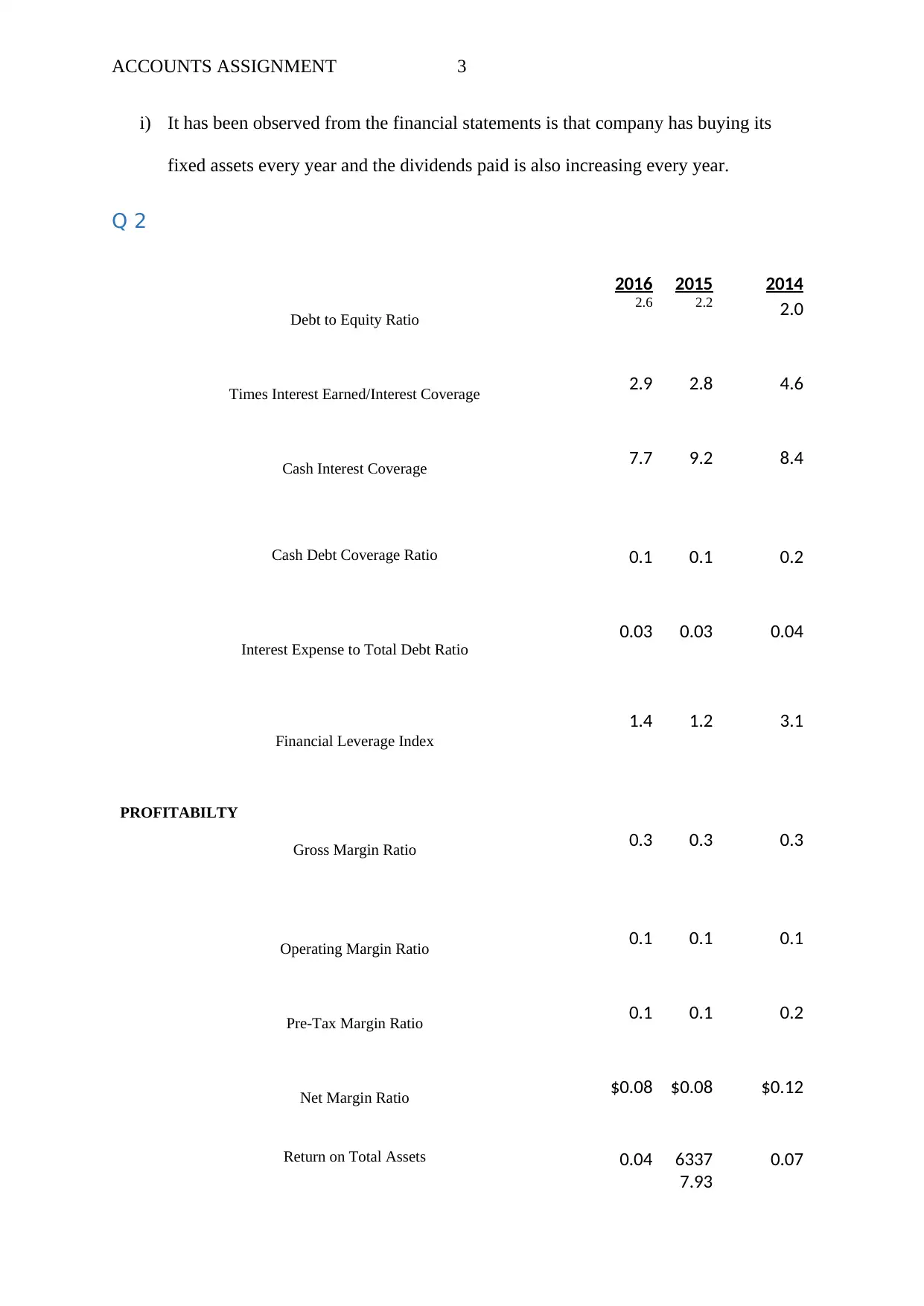
ACCOUNTS ASSIGNMENT 3
i) It has been observed from the financial statements is that company has buying its
fixed assets every year and the dividends paid is also increasing every year.
Q 2
2016 2015 2014
Debt to Equity Ratio
2.6 2.2 2.0
Times Interest Earned/Interest Coverage 2.9 2.8 4.6
Cash Interest Coverage 7.7 9.2 8.4
Cash Debt Coverage Ratio 0.1 0.1 0.2
Interest Expense to Total Debt Ratio
0.03 0.03 0.04
Financial Leverage Index
1.4 1.2 3.1
PROFITABILTY
Gross Margin Ratio 0.3 0.3 0.3
Operating Margin Ratio 0.1 0.1 0.1
Pre-Tax Margin Ratio 0.1 0.1 0.2
Net Margin Ratio $0.08 $0.08 $0.12
Return on Total Assets 0.04 6337
7.93
0.07
i) It has been observed from the financial statements is that company has buying its
fixed assets every year and the dividends paid is also increasing every year.
Q 2
2016 2015 2014
Debt to Equity Ratio
2.6 2.2 2.0
Times Interest Earned/Interest Coverage 2.9 2.8 4.6
Cash Interest Coverage 7.7 9.2 8.4
Cash Debt Coverage Ratio 0.1 0.1 0.2
Interest Expense to Total Debt Ratio
0.03 0.03 0.04
Financial Leverage Index
1.4 1.2 3.1
PROFITABILTY
Gross Margin Ratio 0.3 0.3 0.3
Operating Margin Ratio 0.1 0.1 0.1
Pre-Tax Margin Ratio 0.1 0.1 0.2
Net Margin Ratio $0.08 $0.08 $0.12
Return on Total Assets 0.04 6337
7.93
0.07
Secure Best Marks with AI Grader
Need help grading? Try our AI Grader for instant feedback on your assignments.

ACCOUNTS ASSIGNMENT 4
Return on Common Equity 0.1 0.1 0.2
Earnings per Share
0.29 0.28 0.45
Book Value per Common Share 1.99 2.09 2.26
Dividend Payout Ratio 0.82 0.91 0.57
Effective Tax Rate 34.0%
35.3
% 21.8%
MARKET
Market Capitalization - measures the size of a firm. The formula is:
Market Capitalization = Share Price x Number of Shares Outstanding
Price-Earnings Ratio 0.35 0.44 0.28
Price-Sales Ratio
Price-Book Ratio 4.98 5.75 5.56
Dividend Yield Ratio 0.02 0.02 0.02
Dividend Coverage Ratio
1.22 1.10 1.77
Current Ratio 1.65 1.70 1.34
Return on Common Equity 0.1 0.1 0.2
Earnings per Share
0.29 0.28 0.45
Book Value per Common Share 1.99 2.09 2.26
Dividend Payout Ratio 0.82 0.91 0.57
Effective Tax Rate 34.0%
35.3
% 21.8%
MARKET
Market Capitalization - measures the size of a firm. The formula is:
Market Capitalization = Share Price x Number of Shares Outstanding
Price-Earnings Ratio 0.35 0.44 0.28
Price-Sales Ratio
Price-Book Ratio 4.98 5.75 5.56
Dividend Yield Ratio 0.02 0.02 0.02
Dividend Coverage Ratio
1.22 1.10 1.77
Current Ratio 1.65 1.70 1.34
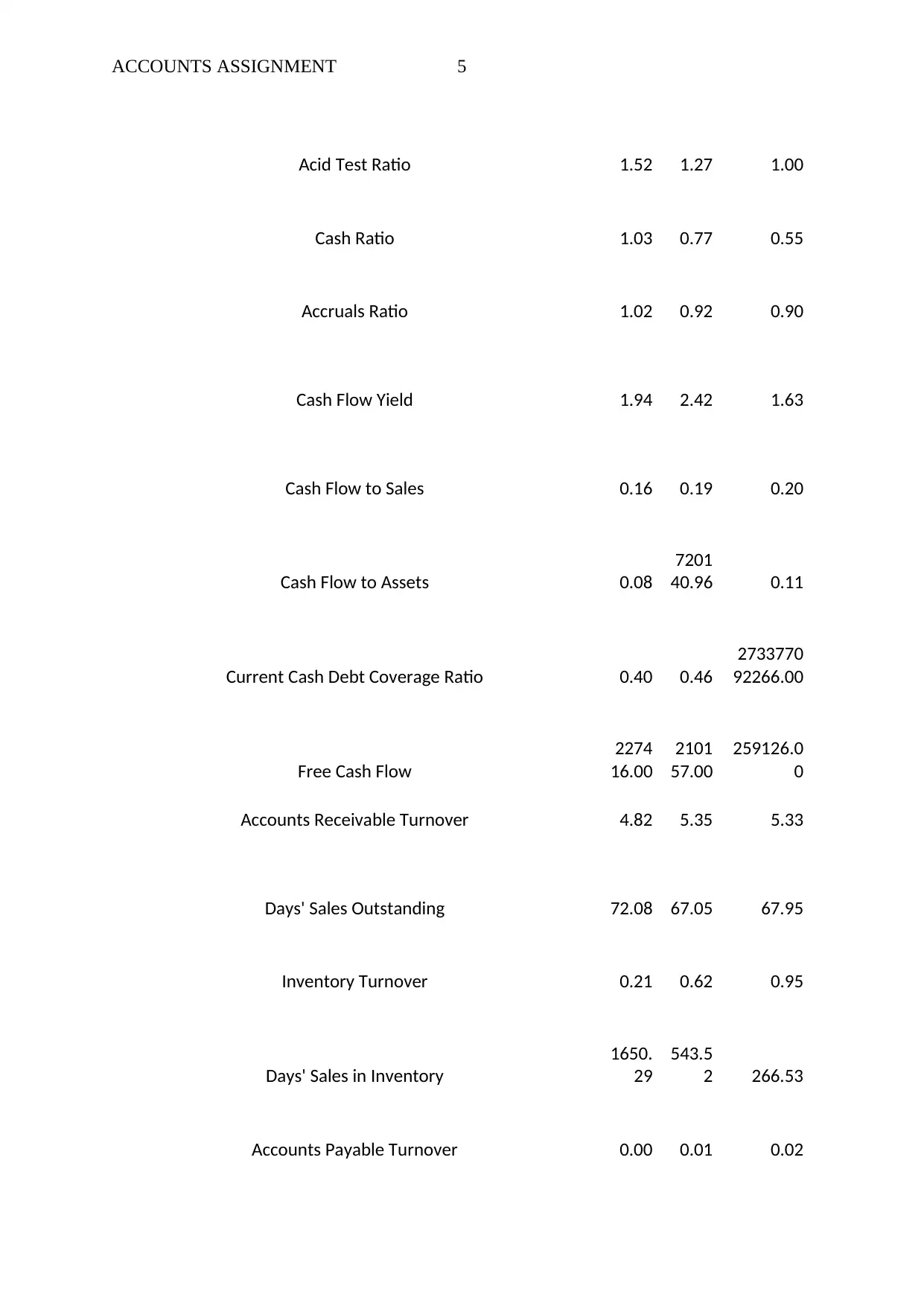
ACCOUNTS ASSIGNMENT 5
Acid Test Ratio 1.52 1.27 1.00
Cash Ratio 1.03 0.77 0.55
Accruals Ratio 1.02 0.92 0.90
Cash Flow Yield 1.94 2.42 1.63
Cash Flow to Sales 0.16 0.19 0.20
Cash Flow to Assets 0.08
7201
40.96 0.11
Current Cash Debt Coverage Ratio 0.40 0.46
2733770
92266.00
Free Cash Flow
2274
16.00
2101
57.00
259126.0
0
Accounts Receivable Turnover 4.82 5.35 5.33
Days' Sales Outstanding 72.08 67.05 67.95
Inventory Turnover 0.21 0.62 0.95
Days' Sales in Inventory
1650.
29
543.5
2 266.53
Accounts Payable Turnover 0.00 0.01 0.02
Acid Test Ratio 1.52 1.27 1.00
Cash Ratio 1.03 0.77 0.55
Accruals Ratio 1.02 0.92 0.90
Cash Flow Yield 1.94 2.42 1.63
Cash Flow to Sales 0.16 0.19 0.20
Cash Flow to Assets 0.08
7201
40.96 0.11
Current Cash Debt Coverage Ratio 0.40 0.46
2733770
92266.00
Free Cash Flow
2274
16.00
2101
57.00
259126.0
0
Accounts Receivable Turnover 4.82 5.35 5.33
Days' Sales Outstanding 72.08 67.05 67.95
Inventory Turnover 0.21 0.62 0.95
Days' Sales in Inventory
1650.
29
543.5
2 266.53
Accounts Payable Turnover 0.00 0.01 0.02

ACCOUNTS ASSIGNMENT 6
Days' Payable Outstanding
1551
86.52
4395
3.21 19741.06
Fixed Asset Turnover 17.36 11.66 11.05
Total Asset Turnover 0.50 0.52 0.54
Cash Conversion Cycle
-
1534
64.14
-
4334
2.64
-
19406.58
Basic Defense Interval
0.003
3
0.001
4 0.0012
Expense Coverage Days
0.003
5
Current Liability Ratio 0.27 0.28 0.33
Cash Turnover 3.63 0.06 4.18
Inventory to Sales Ratio 0.00 0.00 0.00
Cash to Current Assets Ratio 0.63 0.45 0.41
Current Assets to Total Debt Ratio 0.36 0.37 0.33
Current Liabilities to Inventory Ratio
186.8
6
149.1
2 148.24
(Source: Annual Report, 2014;2015;2016).
Days' Payable Outstanding
1551
86.52
4395
3.21 19741.06
Fixed Asset Turnover 17.36 11.66 11.05
Total Asset Turnover 0.50 0.52 0.54
Cash Conversion Cycle
-
1534
64.14
-
4334
2.64
-
19406.58
Basic Defense Interval
0.003
3
0.001
4 0.0012
Expense Coverage Days
0.003
5
Current Liability Ratio 0.27 0.28 0.33
Cash Turnover 3.63 0.06 4.18
Inventory to Sales Ratio 0.00 0.00 0.00
Cash to Current Assets Ratio 0.63 0.45 0.41
Current Assets to Total Debt Ratio 0.36 0.37 0.33
Current Liabilities to Inventory Ratio
186.8
6
149.1
2 148.24
(Source: Annual Report, 2014;2015;2016).
Paraphrase This Document
Need a fresh take? Get an instant paraphrase of this document with our AI Paraphraser
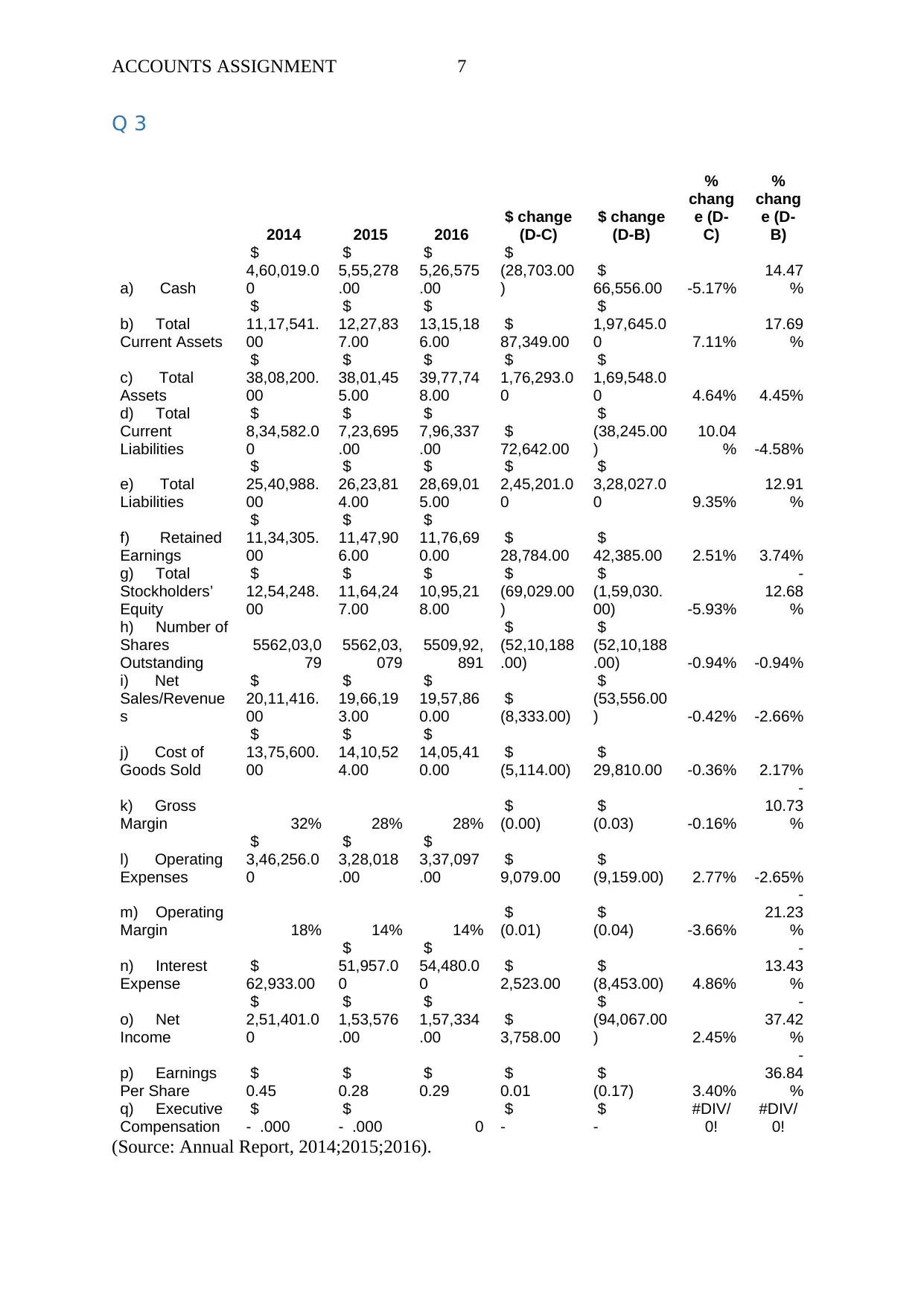
ACCOUNTS ASSIGNMENT 7
Q 3
2014 2015 2016
$ change
(D-C)
$ change
(D-B)
%
chang
e (D-
C)
%
chang
e (D-
B)
a) Cash
$
4,60,019.0
0
$
5,55,278
.00
$
5,26,575
.00
$
(28,703.00
)
$
66,556.00 -5.17%
14.47
%
b) Total
Current Assets
$
11,17,541.
00
$
12,27,83
7.00
$
13,15,18
6.00
$
87,349.00
$
1,97,645.0
0 7.11%
17.69
%
c) Total
Assets
$
38,08,200.
00
$
38,01,45
5.00
$
39,77,74
8.00
$
1,76,293.0
0
$
1,69,548.0
0 4.64% 4.45%
d) Total
Current
Liabilities
$
8,34,582.0
0
$
7,23,695
.00
$
7,96,337
.00
$
72,642.00
$
(38,245.00
)
10.04
% -4.58%
e) Total
Liabilities
$
25,40,988.
00
$
26,23,81
4.00
$
28,69,01
5.00
$
2,45,201.0
0
$
3,28,027.0
0 9.35%
12.91
%
f) Retained
Earnings
$
11,34,305.
00
$
11,47,90
6.00
$
11,76,69
0.00
$
28,784.00
$
42,385.00 2.51% 3.74%
g) Total
Stockholders’
Equity
$
12,54,248.
00
$
11,64,24
7.00
$
10,95,21
8.00
$
(69,029.00
)
$
(1,59,030.
00) -5.93%
-
12.68
%
h) Number of
Shares
Outstanding
5562,03,0
79
5562,03,
079
5509,92,
891
$
(52,10,188
.00)
$
(52,10,188
.00) -0.94% -0.94%
i) Net
Sales/Revenue
s
$
20,11,416.
00
$
19,66,19
3.00
$
19,57,86
0.00
$
(8,333.00)
$
(53,556.00
) -0.42% -2.66%
j) Cost of
Goods Sold
$
13,75,600.
00
$
14,10,52
4.00
$
14,05,41
0.00
$
(5,114.00)
$
29,810.00 -0.36% 2.17%
k) Gross
Margin 32% 28% 28%
$
(0.00)
$
(0.03) -0.16%
-
10.73
%
l) Operating
Expenses
$
3,46,256.0
0
$
3,28,018
.00
$
3,37,097
.00
$
9,079.00
$
(9,159.00) 2.77% -2.65%
m) Operating
Margin 18% 14% 14%
$
(0.01)
$
(0.04) -3.66%
-
21.23
%
n) Interest
Expense
$
62,933.00
$
51,957.0
0
$
54,480.0
0
$
2,523.00
$
(8,453.00) 4.86%
-
13.43
%
o) Net
Income
$
2,51,401.0
0
$
1,53,576
.00
$
1,57,334
.00
$
3,758.00
$
(94,067.00
) 2.45%
-
37.42
%
p) Earnings
Per Share
$
0.45
$
0.28
$
0.29
$
0.01
$
(0.17) 3.40%
-
36.84
%
q) Executive
Compensation
$
- .000
$
- .000 0
$
-
$
-
#DIV/
0!
#DIV/
0!
(Source: Annual Report, 2014;2015;2016).
Q 3
2014 2015 2016
$ change
(D-C)
$ change
(D-B)
%
chang
e (D-
C)
%
chang
e (D-
B)
a) Cash
$
4,60,019.0
0
$
5,55,278
.00
$
5,26,575
.00
$
(28,703.00
)
$
66,556.00 -5.17%
14.47
%
b) Total
Current Assets
$
11,17,541.
00
$
12,27,83
7.00
$
13,15,18
6.00
$
87,349.00
$
1,97,645.0
0 7.11%
17.69
%
c) Total
Assets
$
38,08,200.
00
$
38,01,45
5.00
$
39,77,74
8.00
$
1,76,293.0
0
$
1,69,548.0
0 4.64% 4.45%
d) Total
Current
Liabilities
$
8,34,582.0
0
$
7,23,695
.00
$
7,96,337
.00
$
72,642.00
$
(38,245.00
)
10.04
% -4.58%
e) Total
Liabilities
$
25,40,988.
00
$
26,23,81
4.00
$
28,69,01
5.00
$
2,45,201.0
0
$
3,28,027.0
0 9.35%
12.91
%
f) Retained
Earnings
$
11,34,305.
00
$
11,47,90
6.00
$
11,76,69
0.00
$
28,784.00
$
42,385.00 2.51% 3.74%
g) Total
Stockholders’
Equity
$
12,54,248.
00
$
11,64,24
7.00
$
10,95,21
8.00
$
(69,029.00
)
$
(1,59,030.
00) -5.93%
-
12.68
%
h) Number of
Shares
Outstanding
5562,03,0
79
5562,03,
079
5509,92,
891
$
(52,10,188
.00)
$
(52,10,188
.00) -0.94% -0.94%
i) Net
Sales/Revenue
s
$
20,11,416.
00
$
19,66,19
3.00
$
19,57,86
0.00
$
(8,333.00)
$
(53,556.00
) -0.42% -2.66%
j) Cost of
Goods Sold
$
13,75,600.
00
$
14,10,52
4.00
$
14,05,41
0.00
$
(5,114.00)
$
29,810.00 -0.36% 2.17%
k) Gross
Margin 32% 28% 28%
$
(0.00)
$
(0.03) -0.16%
-
10.73
%
l) Operating
Expenses
$
3,46,256.0
0
$
3,28,018
.00
$
3,37,097
.00
$
9,079.00
$
(9,159.00) 2.77% -2.65%
m) Operating
Margin 18% 14% 14%
$
(0.01)
$
(0.04) -3.66%
-
21.23
%
n) Interest
Expense
$
62,933.00
$
51,957.0
0
$
54,480.0
0
$
2,523.00
$
(8,453.00) 4.86%
-
13.43
%
o) Net
Income
$
2,51,401.0
0
$
1,53,576
.00
$
1,57,334
.00
$
3,758.00
$
(94,067.00
) 2.45%
-
37.42
%
p) Earnings
Per Share
$
0.45
$
0.28
$
0.29
$
0.01
$
(0.17) 3.40%
-
36.84
%
q) Executive
Compensation
$
- .000
$
- .000 0
$
-
$
-
#DIV/
0!
#DIV/
0!
(Source: Annual Report, 2014;2015;2016).
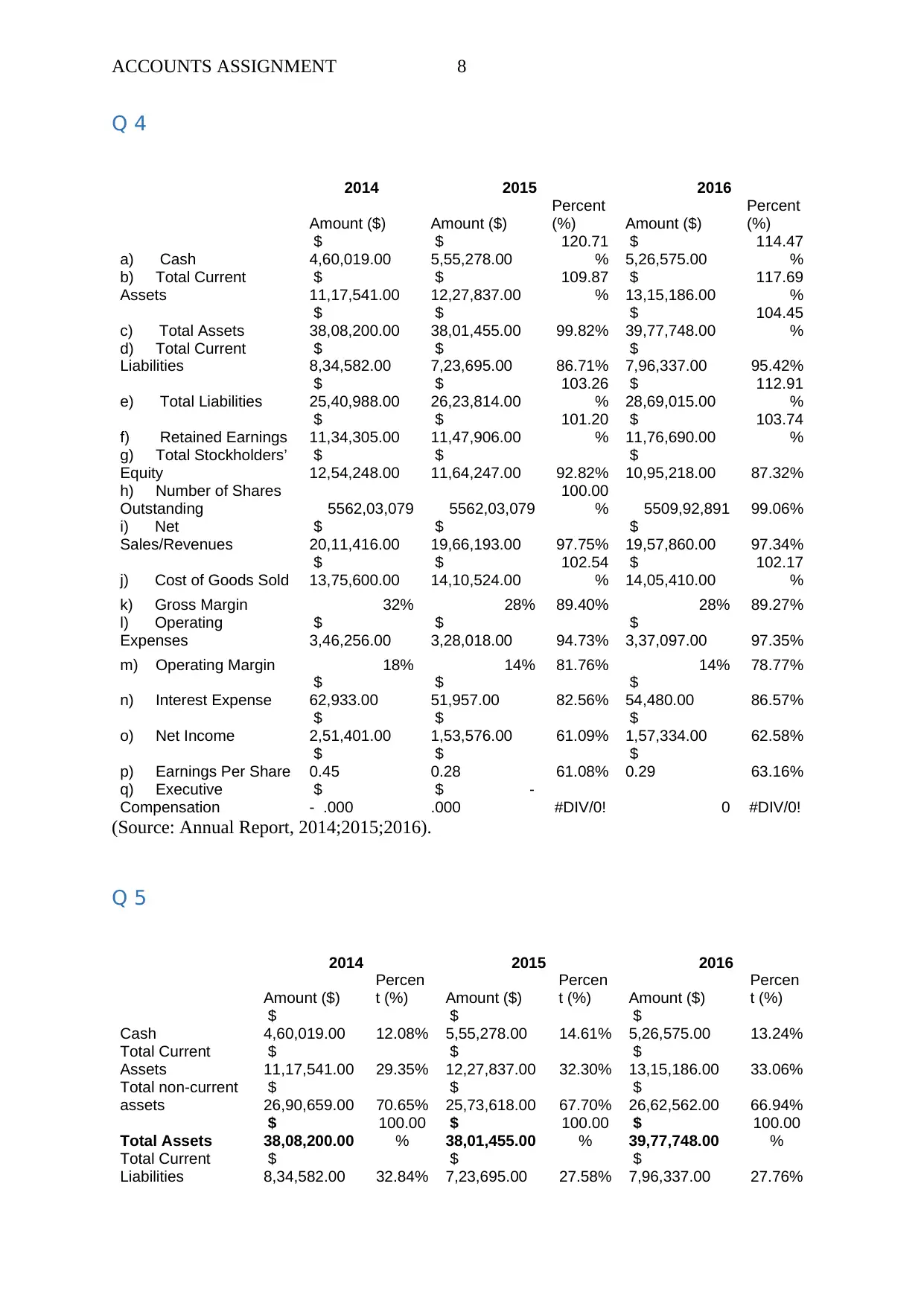
ACCOUNTS ASSIGNMENT 8
Q 4
2014 2015 2016
Amount ($) Amount ($)
Percent
(%) Amount ($)
Percent
(%)
a) Cash
$
4,60,019.00
$
5,55,278.00
120.71
%
$
5,26,575.00
114.47
%
b) Total Current
Assets
$
11,17,541.00
$
12,27,837.00
109.87
%
$
13,15,186.00
117.69
%
c) Total Assets
$
38,08,200.00
$
38,01,455.00 99.82%
$
39,77,748.00
104.45
%
d) Total Current
Liabilities
$
8,34,582.00
$
7,23,695.00 86.71%
$
7,96,337.00 95.42%
e) Total Liabilities
$
25,40,988.00
$
26,23,814.00
103.26
%
$
28,69,015.00
112.91
%
f) Retained Earnings
$
11,34,305.00
$
11,47,906.00
101.20
%
$
11,76,690.00
103.74
%
g) Total Stockholders’
Equity
$
12,54,248.00
$
11,64,247.00 92.82%
$
10,95,218.00 87.32%
h) Number of Shares
Outstanding 5562,03,079 5562,03,079
100.00
% 5509,92,891 99.06%
i) Net
Sales/Revenues
$
20,11,416.00
$
19,66,193.00 97.75%
$
19,57,860.00 97.34%
j) Cost of Goods Sold
$
13,75,600.00
$
14,10,524.00
102.54
%
$
14,05,410.00
102.17
%
k) Gross Margin 32% 28% 89.40% 28% 89.27%
l) Operating
Expenses
$
3,46,256.00
$
3,28,018.00 94.73%
$
3,37,097.00 97.35%
m) Operating Margin 18% 14% 81.76% 14% 78.77%
n) Interest Expense
$
62,933.00
$
51,957.00 82.56%
$
54,480.00 86.57%
o) Net Income
$
2,51,401.00
$
1,53,576.00 61.09%
$
1,57,334.00 62.58%
p) Earnings Per Share
$
0.45
$
0.28 61.08%
$
0.29 63.16%
q) Executive
Compensation
$
- .000
$ -
.000 #DIV/0! 0 #DIV/0!
(Source: Annual Report, 2014;2015;2016).
Q 5
2014 2015 2016
Amount ($)
Percen
t (%) Amount ($)
Percen
t (%) Amount ($)
Percen
t (%)
Cash
$
4,60,019.00 12.08%
$
5,55,278.00 14.61%
$
5,26,575.00 13.24%
Total Current
Assets
$
11,17,541.00 29.35%
$
12,27,837.00 32.30%
$
13,15,186.00 33.06%
Total non-current
assets
$
26,90,659.00 70.65%
$
25,73,618.00 67.70%
$
26,62,562.00 66.94%
Total Assets
$
38,08,200.00
100.00
%
$
38,01,455.00
100.00
%
$
39,77,748.00
100.00
%
Total Current
Liabilities
$
8,34,582.00 32.84%
$
7,23,695.00 27.58%
$
7,96,337.00 27.76%
Q 4
2014 2015 2016
Amount ($) Amount ($)
Percent
(%) Amount ($)
Percent
(%)
a) Cash
$
4,60,019.00
$
5,55,278.00
120.71
%
$
5,26,575.00
114.47
%
b) Total Current
Assets
$
11,17,541.00
$
12,27,837.00
109.87
%
$
13,15,186.00
117.69
%
c) Total Assets
$
38,08,200.00
$
38,01,455.00 99.82%
$
39,77,748.00
104.45
%
d) Total Current
Liabilities
$
8,34,582.00
$
7,23,695.00 86.71%
$
7,96,337.00 95.42%
e) Total Liabilities
$
25,40,988.00
$
26,23,814.00
103.26
%
$
28,69,015.00
112.91
%
f) Retained Earnings
$
11,34,305.00
$
11,47,906.00
101.20
%
$
11,76,690.00
103.74
%
g) Total Stockholders’
Equity
$
12,54,248.00
$
11,64,247.00 92.82%
$
10,95,218.00 87.32%
h) Number of Shares
Outstanding 5562,03,079 5562,03,079
100.00
% 5509,92,891 99.06%
i) Net
Sales/Revenues
$
20,11,416.00
$
19,66,193.00 97.75%
$
19,57,860.00 97.34%
j) Cost of Goods Sold
$
13,75,600.00
$
14,10,524.00
102.54
%
$
14,05,410.00
102.17
%
k) Gross Margin 32% 28% 89.40% 28% 89.27%
l) Operating
Expenses
$
3,46,256.00
$
3,28,018.00 94.73%
$
3,37,097.00 97.35%
m) Operating Margin 18% 14% 81.76% 14% 78.77%
n) Interest Expense
$
62,933.00
$
51,957.00 82.56%
$
54,480.00 86.57%
o) Net Income
$
2,51,401.00
$
1,53,576.00 61.09%
$
1,57,334.00 62.58%
p) Earnings Per Share
$
0.45
$
0.28 61.08%
$
0.29 63.16%
q) Executive
Compensation
$
- .000
$ -
.000 #DIV/0! 0 #DIV/0!
(Source: Annual Report, 2014;2015;2016).
Q 5
2014 2015 2016
Amount ($)
Percen
t (%) Amount ($)
Percen
t (%) Amount ($)
Percen
t (%)
Cash
$
4,60,019.00 12.08%
$
5,55,278.00 14.61%
$
5,26,575.00 13.24%
Total Current
Assets
$
11,17,541.00 29.35%
$
12,27,837.00 32.30%
$
13,15,186.00 33.06%
Total non-current
assets
$
26,90,659.00 70.65%
$
25,73,618.00 67.70%
$
26,62,562.00 66.94%
Total Assets
$
38,08,200.00
100.00
%
$
38,01,455.00
100.00
%
$
39,77,748.00
100.00
%
Total Current
Liabilities
$
8,34,582.00 32.84%
$
7,23,695.00 27.58%
$
7,96,337.00 27.76%
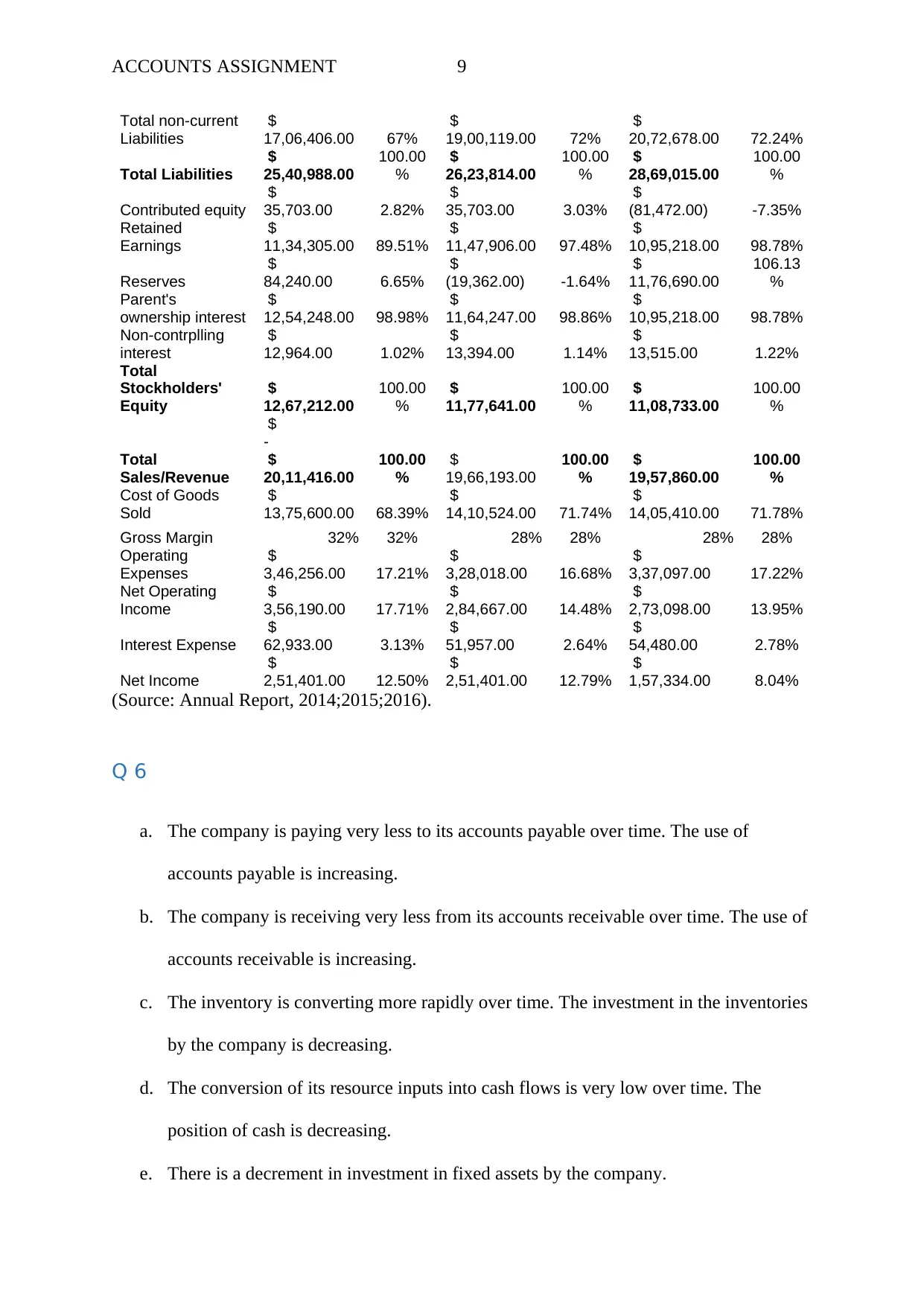
ACCOUNTS ASSIGNMENT 9
Total non-current
Liabilities
$
17,06,406.00 67%
$
19,00,119.00 72%
$
20,72,678.00 72.24%
Total Liabilities
$
25,40,988.00
100.00
%
$
26,23,814.00
100.00
%
$
28,69,015.00
100.00
%
Contributed equity
$
35,703.00 2.82%
$
35,703.00 3.03%
$
(81,472.00) -7.35%
Retained
Earnings
$
11,34,305.00 89.51%
$
11,47,906.00 97.48%
$
10,95,218.00 98.78%
Reserves
$
84,240.00 6.65%
$
(19,362.00) -1.64%
$
11,76,690.00
106.13
%
Parent's
ownership interest
$
12,54,248.00 98.98%
$
11,64,247.00 98.86%
$
10,95,218.00 98.78%
Non-contrplling
interest
$
12,964.00 1.02%
$
13,394.00 1.14%
$
13,515.00 1.22%
Total
Stockholders'
Equity
$
12,67,212.00
100.00
%
$
11,77,641.00
100.00
%
$
11,08,733.00
100.00
%
$
-
Total
Sales/Revenue
$
20,11,416.00
100.00
%
$
19,66,193.00
100.00
%
$
19,57,860.00
100.00
%
Cost of Goods
Sold
$
13,75,600.00 68.39%
$
14,10,524.00 71.74%
$
14,05,410.00 71.78%
Gross Margin 32% 32% 28% 28% 28% 28%
Operating
Expenses
$
3,46,256.00 17.21%
$
3,28,018.00 16.68%
$
3,37,097.00 17.22%
Net Operating
Income
$
3,56,190.00 17.71%
$
2,84,667.00 14.48%
$
2,73,098.00 13.95%
Interest Expense
$
62,933.00 3.13%
$
51,957.00 2.64%
$
54,480.00 2.78%
Net Income
$
2,51,401.00 12.50%
$
2,51,401.00 12.79%
$
1,57,334.00 8.04%
(Source: Annual Report, 2014;2015;2016).
Q 6
a. The company is paying very less to its accounts payable over time. The use of
accounts payable is increasing.
b. The company is receiving very less from its accounts receivable over time. The use of
accounts receivable is increasing.
c. The inventory is converting more rapidly over time. The investment in the inventories
by the company is decreasing.
d. The conversion of its resource inputs into cash flows is very low over time. The
position of cash is decreasing.
e. There is a decrement in investment in fixed assets by the company.
Total non-current
Liabilities
$
17,06,406.00 67%
$
19,00,119.00 72%
$
20,72,678.00 72.24%
Total Liabilities
$
25,40,988.00
100.00
%
$
26,23,814.00
100.00
%
$
28,69,015.00
100.00
%
Contributed equity
$
35,703.00 2.82%
$
35,703.00 3.03%
$
(81,472.00) -7.35%
Retained
Earnings
$
11,34,305.00 89.51%
$
11,47,906.00 97.48%
$
10,95,218.00 98.78%
Reserves
$
84,240.00 6.65%
$
(19,362.00) -1.64%
$
11,76,690.00
106.13
%
Parent's
ownership interest
$
12,54,248.00 98.98%
$
11,64,247.00 98.86%
$
10,95,218.00 98.78%
Non-contrplling
interest
$
12,964.00 1.02%
$
13,394.00 1.14%
$
13,515.00 1.22%
Total
Stockholders'
Equity
$
12,67,212.00
100.00
%
$
11,77,641.00
100.00
%
$
11,08,733.00
100.00
%
$
-
Total
Sales/Revenue
$
20,11,416.00
100.00
%
$
19,66,193.00
100.00
%
$
19,57,860.00
100.00
%
Cost of Goods
Sold
$
13,75,600.00 68.39%
$
14,10,524.00 71.74%
$
14,05,410.00 71.78%
Gross Margin 32% 32% 28% 28% 28% 28%
Operating
Expenses
$
3,46,256.00 17.21%
$
3,28,018.00 16.68%
$
3,37,097.00 17.22%
Net Operating
Income
$
3,56,190.00 17.71%
$
2,84,667.00 14.48%
$
2,73,098.00 13.95%
Interest Expense
$
62,933.00 3.13%
$
51,957.00 2.64%
$
54,480.00 2.78%
Net Income
$
2,51,401.00 12.50%
$
2,51,401.00 12.79%
$
1,57,334.00 8.04%
(Source: Annual Report, 2014;2015;2016).
Q 6
a. The company is paying very less to its accounts payable over time. The use of
accounts payable is increasing.
b. The company is receiving very less from its accounts receivable over time. The use of
accounts receivable is increasing.
c. The inventory is converting more rapidly over time. The investment in the inventories
by the company is decreasing.
d. The conversion of its resource inputs into cash flows is very low over time. The
position of cash is decreasing.
e. There is a decrement in investment in fixed assets by the company.
Secure Best Marks with AI Grader
Need help grading? Try our AI Grader for instant feedback on your assignments.

ACCOUNTS ASSIGNMENT 10
f. The assets are not managed by the company very efficiently.
g. The usage of long-term debt is increasing by the company.
h. The debts are more efficiently utilised by the company.
i. The stockholder’s investment is becoming more profitable/
j. The operating revenues are decreased over time by 0.50%.
k. The operating expenses are increased over time by 0.24%.
l. The market capitalization decrease significantly over time.
m. The times interest earned increase over time.
n. The dividend pay-out ratio decrease over time.
o. The effective tax rate decrease over time.
p. The estimated interest rate increase over time.
q. The free cash flow decrease over time.
r. The earnings per share increase over time.
s. The book value per share decrease over time.
t. The price-earnings ratio decrease over time.
u. The trends of the various ratios of profitability ratios shows declination.
v. The trends of the various ratios of profitability ratios shows improvement.
w. The trends of the various ratios of profitability ratios shows improvement.
x. The trends of the various ratios of profitability ratios shows improvement.
y. The trends of the various ratios of profitability ratios shows improvement.
z. There are no differences in the accounting methods.
Q 7
It has been observed from the calculation of the ratios for the three previous years is
that the company’s performance is enhanced and thus can be said that the company is capable
f. The assets are not managed by the company very efficiently.
g. The usage of long-term debt is increasing by the company.
h. The debts are more efficiently utilised by the company.
i. The stockholder’s investment is becoming more profitable/
j. The operating revenues are decreased over time by 0.50%.
k. The operating expenses are increased over time by 0.24%.
l. The market capitalization decrease significantly over time.
m. The times interest earned increase over time.
n. The dividend pay-out ratio decrease over time.
o. The effective tax rate decrease over time.
p. The estimated interest rate increase over time.
q. The free cash flow decrease over time.
r. The earnings per share increase over time.
s. The book value per share decrease over time.
t. The price-earnings ratio decrease over time.
u. The trends of the various ratios of profitability ratios shows declination.
v. The trends of the various ratios of profitability ratios shows improvement.
w. The trends of the various ratios of profitability ratios shows improvement.
x. The trends of the various ratios of profitability ratios shows improvement.
y. The trends of the various ratios of profitability ratios shows improvement.
z. There are no differences in the accounting methods.
Q 7
It has been observed from the calculation of the ratios for the three previous years is
that the company’s performance is enhanced and thus can be said that the company is capable
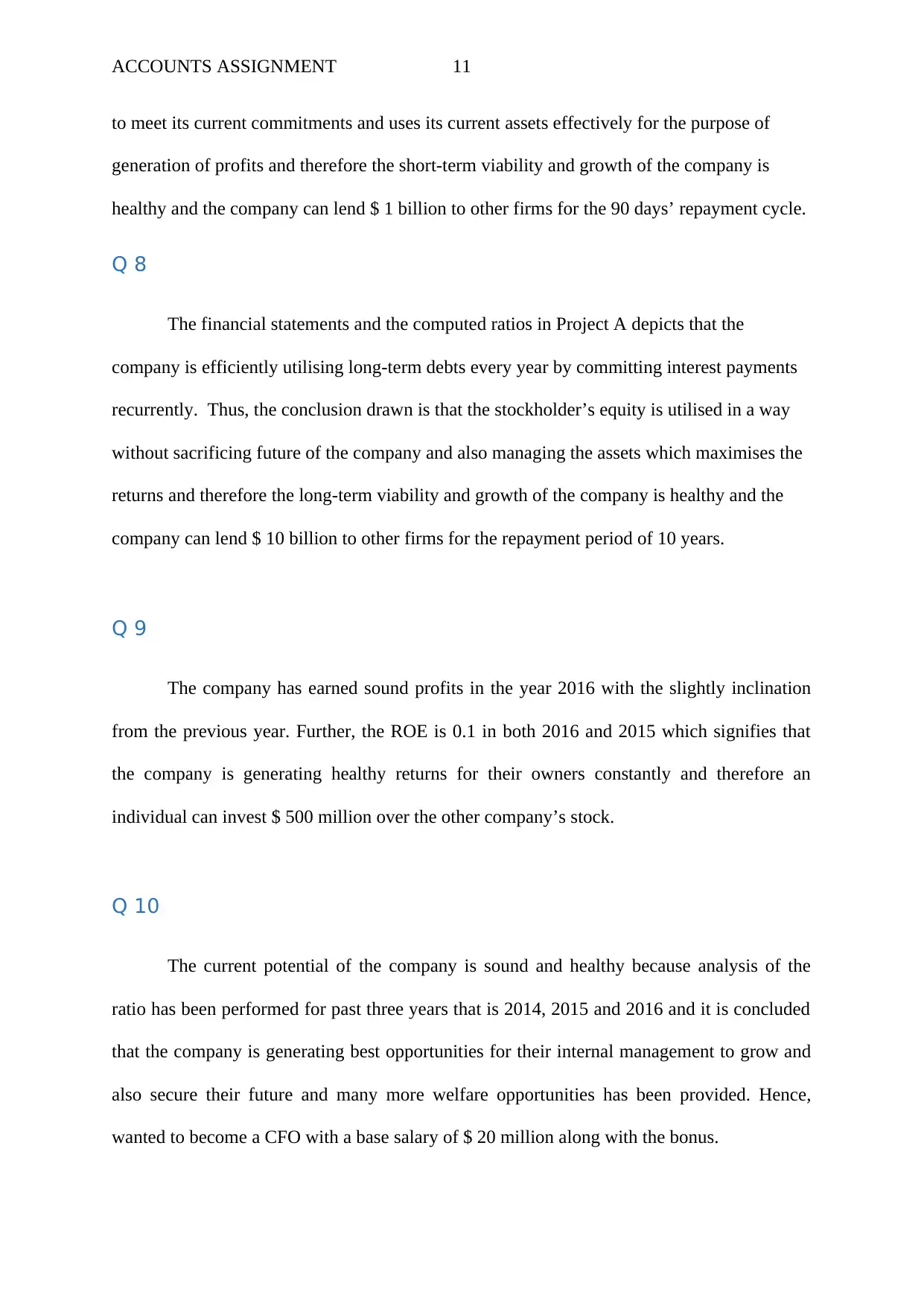
ACCOUNTS ASSIGNMENT 11
to meet its current commitments and uses its current assets effectively for the purpose of
generation of profits and therefore the short-term viability and growth of the company is
healthy and the company can lend $ 1 billion to other firms for the 90 days’ repayment cycle.
Q 8
The financial statements and the computed ratios in Project A depicts that the
company is efficiently utilising long-term debts every year by committing interest payments
recurrently. Thus, the conclusion drawn is that the stockholder’s equity is utilised in a way
without sacrificing future of the company and also managing the assets which maximises the
returns and therefore the long-term viability and growth of the company is healthy and the
company can lend $ 10 billion to other firms for the repayment period of 10 years.
Q 9
The company has earned sound profits in the year 2016 with the slightly inclination
from the previous year. Further, the ROE is 0.1 in both 2016 and 2015 which signifies that
the company is generating healthy returns for their owners constantly and therefore an
individual can invest $ 500 million over the other company’s stock.
Q 10
The current potential of the company is sound and healthy because analysis of the
ratio has been performed for past three years that is 2014, 2015 and 2016 and it is concluded
that the company is generating best opportunities for their internal management to grow and
also secure their future and many more welfare opportunities has been provided. Hence,
wanted to become a CFO with a base salary of $ 20 million along with the bonus.
to meet its current commitments and uses its current assets effectively for the purpose of
generation of profits and therefore the short-term viability and growth of the company is
healthy and the company can lend $ 1 billion to other firms for the 90 days’ repayment cycle.
Q 8
The financial statements and the computed ratios in Project A depicts that the
company is efficiently utilising long-term debts every year by committing interest payments
recurrently. Thus, the conclusion drawn is that the stockholder’s equity is utilised in a way
without sacrificing future of the company and also managing the assets which maximises the
returns and therefore the long-term viability and growth of the company is healthy and the
company can lend $ 10 billion to other firms for the repayment period of 10 years.
Q 9
The company has earned sound profits in the year 2016 with the slightly inclination
from the previous year. Further, the ROE is 0.1 in both 2016 and 2015 which signifies that
the company is generating healthy returns for their owners constantly and therefore an
individual can invest $ 500 million over the other company’s stock.
Q 10
The current potential of the company is sound and healthy because analysis of the
ratio has been performed for past three years that is 2014, 2015 and 2016 and it is concluded
that the company is generating best opportunities for their internal management to grow and
also secure their future and many more welfare opportunities has been provided. Hence,
wanted to become a CFO with a base salary of $ 20 million along with the bonus.
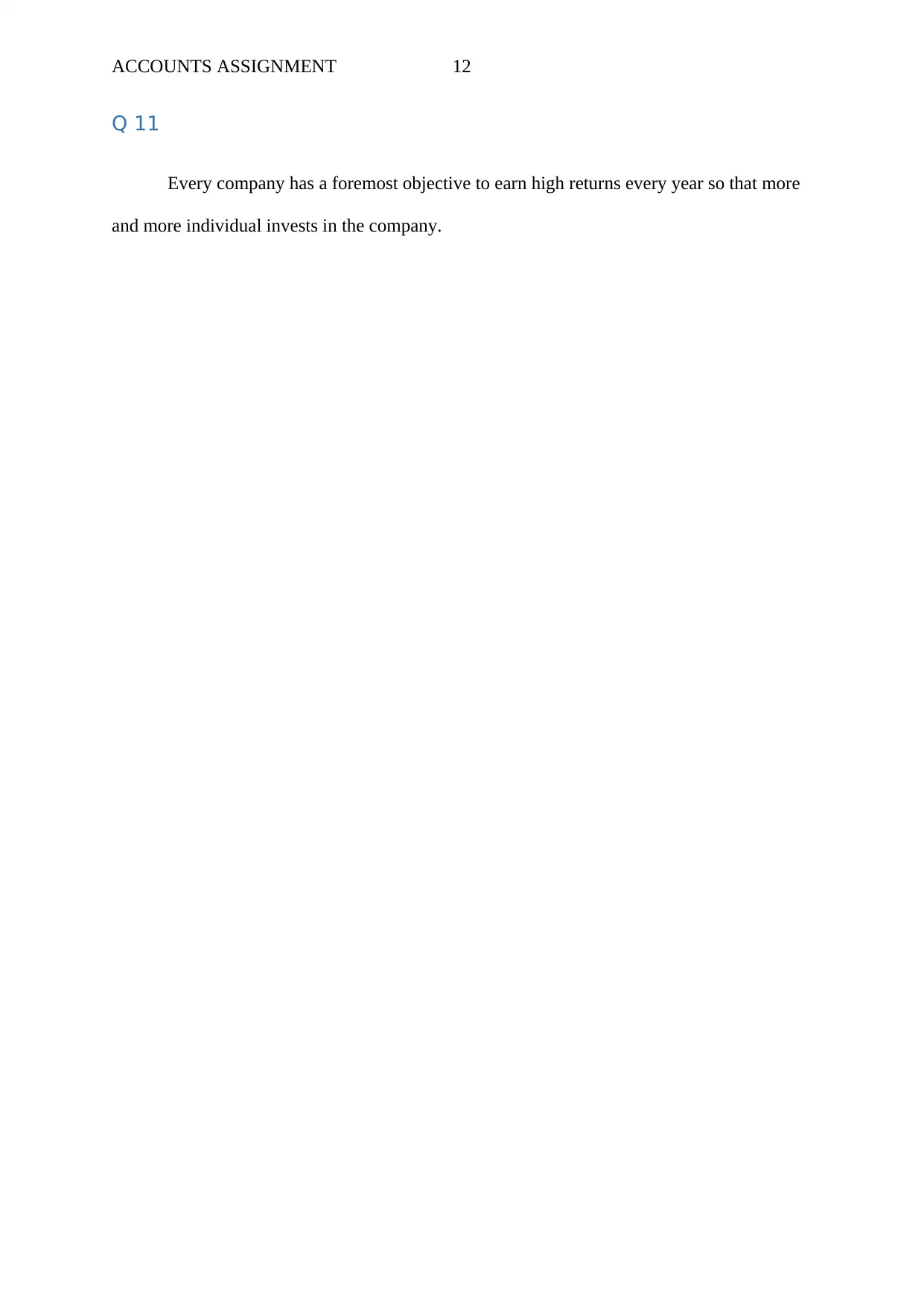
ACCOUNTS ASSIGNMENT 12
Q 11
Every company has a foremost objective to earn high returns every year so that more
and more individual invests in the company.
Q 11
Every company has a foremost objective to earn high returns every year so that more
and more individual invests in the company.
Paraphrase This Document
Need a fresh take? Get an instant paraphrase of this document with our AI Paraphraser
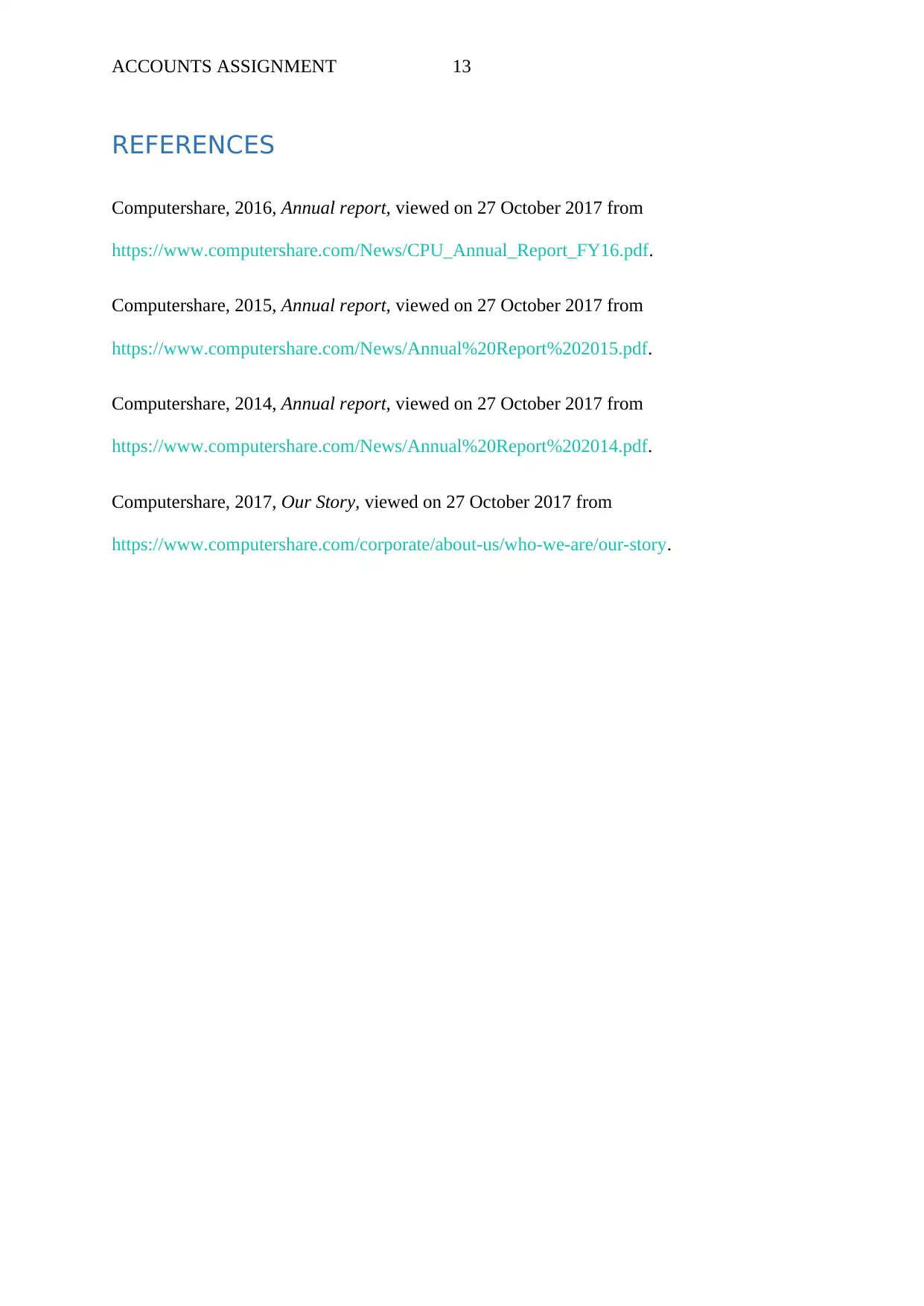
ACCOUNTS ASSIGNMENT 13
REFERENCES
Computershare, 2016, Annual report, viewed on 27 October 2017 from
https://www.computershare.com/News/CPU_Annual_Report_FY16.pdf.
Computershare, 2015, Annual report, viewed on 27 October 2017 from
https://www.computershare.com/News/Annual%20Report%202015.pdf.
Computershare, 2014, Annual report, viewed on 27 October 2017 from
https://www.computershare.com/News/Annual%20Report%202014.pdf.
Computershare, 2017, Our Story, viewed on 27 October 2017 from
https://www.computershare.com/corporate/about-us/who-we-are/our-story.
REFERENCES
Computershare, 2016, Annual report, viewed on 27 October 2017 from
https://www.computershare.com/News/CPU_Annual_Report_FY16.pdf.
Computershare, 2015, Annual report, viewed on 27 October 2017 from
https://www.computershare.com/News/Annual%20Report%202015.pdf.
Computershare, 2014, Annual report, viewed on 27 October 2017 from
https://www.computershare.com/News/Annual%20Report%202014.pdf.
Computershare, 2017, Our Story, viewed on 27 October 2017 from
https://www.computershare.com/corporate/about-us/who-we-are/our-story.
1 out of 14
Related Documents
Your All-in-One AI-Powered Toolkit for Academic Success.
+13062052269
info@desklib.com
Available 24*7 on WhatsApp / Email
![[object Object]](/_next/static/media/star-bottom.7253800d.svg)
Unlock your academic potential
© 2024 | Zucol Services PVT LTD | All rights reserved.





